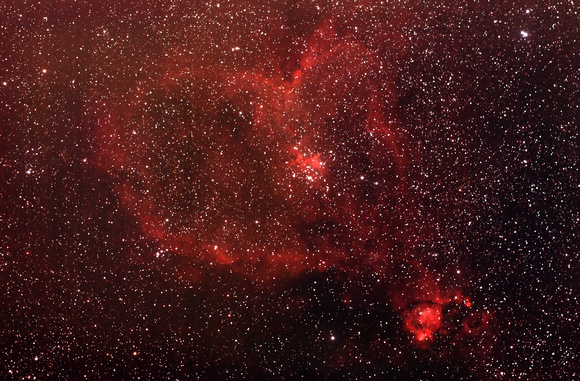IC 1805 - The Heart Nebula
Other Names: SH-2-190
Optics: Borg Astrograph 101ED at f/4.1
Mount: Atlas EQG using The Sky6 and EQMOD
Camera: Canon EOS 50D [ UV/IR filter modification by Hap Griffin ]
Filters: IDAS Light Pollution Suppression (LPS) Filter
Exposure: 140 Mins [28 x 300s at ISO 800]
Accessories: Auto guided with Borg 45ED and Orion Starshoot Auto guider using PHD
Location: Calgary, AB
Date: October 16th, 2010
Notes: Processing: Image acquisition with Maxim DSLR. Image calibration, align, and combine in Maxim DSLR. Levels, curves, Noise Ninja, crop and resize in Photoshop.
Calibrated w/35 Darks, 40 Bias, 40 Flats using light box Ambient temperature was between +1.2 and -0.8C
The Heart Nebula, IC 1805, Sh2-190, lies some 7500 light years away from Earth and is located in the Perseus arm of the Galaxy in the constellation Cassiopeia. This is an emission nebula showing glowing gas and darker dust lanes. The nebula is formed by plasma of ionized hydrogen and free electrons.
The very brightest part of this nebula (the knot at the right) is separately classified as NGC 896, because it was the first part of this nebula to be discovered.
The nebula's intense red output and its configuration are driven by the radiation emanating from a small group of stars near the nebula's center. This open cluster of stars known as Melotte 15 contains a few bright stars nearly 50 times the mass of our Sun, and many more dim stars that are only a fraction of our Sun's mass. The cluster used to contain a microquasar that was expelled millions of years ago.


